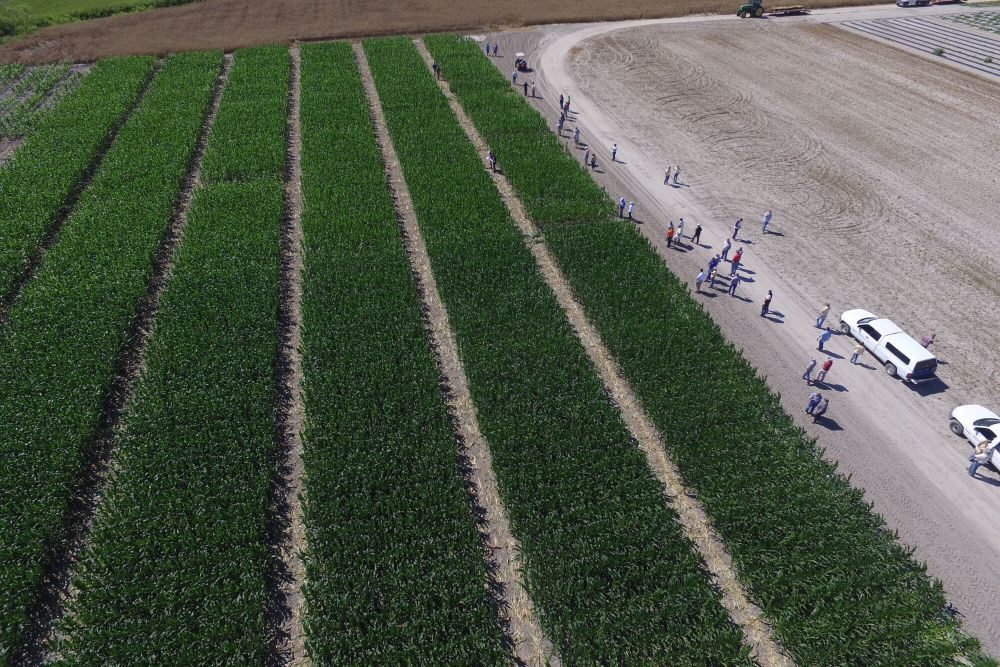
Weed Science

Program overview
The University of Delaware Weed Science Program provides continuing education on the principles of weed science, and training on effective and responsible weed control practices. UD Weed Science conducts unbiased studies for weed control of agronomic crops and commercial vegetables. Chemical, mechanical, and cultural practices are evaluated. Results and recommendations are made available to farmers and agribusinesses through publications, county and state-wide meetings, and field days throughout the year. UD Weed Science informs the agricultural community of emerging weed issues.
These guides are technical bulletins that provide technical information on managing key weeds in agronomic crops and commercial vegetables. Bulletins include control of Delaware’s noxious weeds. Often the information is specific to Delaware or the mid-Atlantic Region.
Learn more about the guide in the video below.
Weed Management Guide: youtube.com/watch?v=wH5AyULjKL0
Additional Weed Management Guides
Factsheets for weed science
Weed science Control Factsheets
- Burcucumber Control in Cropland Updated (3/19)
- Canada Thistle Control in Cropland Updated (3/19)
- Giant Ragweed Control in Cropland Updated (3/19)
- Johnsongrass Control in Cropland Updated (3/19)
- Palmer Amaranth Control in Cropland Updated (3/19)
- Texas Panicum Control in Field Crops and Commercial Vegetables Updated (3/19)
- Perennial Weed Control
Delaware Soybean Board Reports
- 2016: Herbicide-Resistant Weed Management for No-Till and Double-Cropped Soybeans
- 2015: Evaluating Herbicide Tankmixtures for Liberty-Link Soybeans
- 2014: Management of Palmer Amaranth in Soybeans
Additional weed management reports
- Tarping for no-till cover crop management
- Integrating Cover Crops for Weed Management in Plasticulture Systems
- 2018: Authority MTZ for processing tomatoes
- 2016: Alternative compounds for preemergence weed control
- 2016: Management of herbicide-resistant common ragweed in soybeans
- 2016: Reflex in pumpkins
- 2016: Control of Problem Weeds in Small Grains
- 2015: Lima bean safety with PPO herbicides
- 2015: Evaluation of potential herbicides for sweet potatoes
- 2014: Japanese knotweed management along ditchbanks
- 2014: Potential Herbicides for Row Middles in Plasticulture Melons
Report books prior to years available online here are available in PDF format upon request. For a copy to be emailed, please contact us and specify the year(s) you would like emailed.
Series of publications developed by Extension Weed Specialists on glyphosate and key weed species.
Studies on the biology and ecology of key weed species in the Northeastern U.S.
Annual results of the UD conducted weed control demonstrations and trials. Trials are conducted at the UD’s Thurman Adams Research Farm (UD-REC) and at various on-farm locations throughout Delaware. Compilation of these trials is the basis of UD Weed Management Recommendations. Extension recommendations are seldom made based on a single trial.
- 2019 Delaware Weed Control Results
- 2018 Delaware Weed Control Results
- 2017 Delaware Weed Control Results
- 2016 Delaware Weed Control Results
- 2015 Delaware Weed Control Results
- 2014 Delaware Weed Control Results
- 2013 Delaware Weed Control Results
- 2012 Delaware Weed Control Results
- 2011 Delaware Weed Control Results
Ppresentations on various topics with information specific to Delaware or the mid-Atlantic Region.
- Weed Control for Snap Beans
- Palmer Amaranth vs Redroot Pigweed
- Weed Management for Sweet Corn and Lima Beans
- Weed Management for Vine Crops
- Winter Weeds - names and photos
Related Fact Sheets
All Results
-
AWARENESS OF POTENTIAL PLANT TOXICITY TO GRAZING ANIMALS
Effects on animal health from consuming or contacting potentially toxic plants can range from none to death. Potential deleterious effects include tainted milk; liver or kidney damage; cardiovascular, nervous system, musculoskeletal, or gastrointestinal problems;
-
CONSIDERATIONS FOR HERBICIDE USE IN PASTURES
Weeds are often not desirable in pastures for many reasons. Many weeds are less palatable to animals, weeds decrease rapidly in nutritive value as they mature, and some can be toxic if consumed in large enough quantities. Weeds can also reduce the amount of desirable vegetation. Weed infestations can often be prevented by implementing cultural practices that maintain a dense cover of desirable forage where weeds find it difficult to germinate and grow.
-
DETERMINING THE PRESENCE OF GLYPHOSATE-RESISTANT HORSEWEED UNDER FIELD CONDITIONS
Glyphosate is the active ingredient in Roundup, Touchdown, Duramax, and numerous other brand names. If resistance is suspected in one of your fields, some questions should be asked to help determine if herbicide resistance is the reason for lack of control.
- 1
- 2
- 3
- 4
Program contacts
Barbara Scott
Research Associate III
Plant and Soil Sciences
(M.A., University of Delaware)
(302) 856-7303
Email: bascott@udel.edu
Claudio Rubione
Extension/Research Associate
Weed Science and GROW
(M.Sc. University of Buenos Aires)
(302) 856-7303
Email: crubione@udel.edu
Website: growiwm.org









